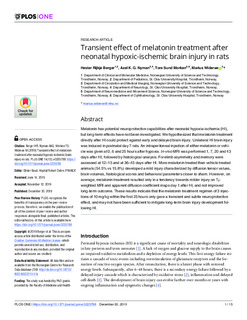| dc.contributor.author | Berger, Hester Rijkje | |
| dc.contributor.author | Nyman, Axel Karl Gottfrid | |
| dc.contributor.author | Morken, Tora Sund | |
| dc.contributor.author | Widerøe, Marius | |
| dc.date.accessioned | 2020-02-18T06:21:27Z | |
| dc.date.available | 2020-02-18T06:21:27Z | |
| dc.date.created | 2020-01-16T12:41:51Z | |
| dc.date.issued | 2019 | |
| dc.identifier.issn | 1932-6203 | |
| dc.identifier.uri | http://hdl.handle.net/11250/2642100 | |
| dc.description.abstract | Melatonin has potential neuroprotective capabilities after neonatal hypoxia-ischemia (HI), but long-term effects have not been investigated. We hypothesized that melatonin treatment directly after HI could protect against early and delayed brain injury. Unilateral HI brain injury was induced in postnatal day 7 rats. An intraperitoneal injection of either melatonin or vehicle was given at 0, 6 and 25 hours after hypoxia. In-vivo MRI was performed 1, 7, 20 and 43 days after HI, followed by histological analysis. Forelimb asymmetry and memory were assessed at 12–15 and at 36–43 days after HI. More melatonin treated than vehicle treated animals (54.5% vs 15.8%) developed a mild injury characterized by diffusion tensor values, brain volumes, histological scores and behavioral parameters closer to sham. However, on average, melatonin treatment resulted only in a tendency towards milder injury on T2-weighted MRI and apparent diffusion coefficient maps day 1 after HI, and not improved long-term outcome. These results indicate that the melatonin treatment regimen of 3 injections of 10 mg/kg within the first 25 hours only gave a transient and subtle neuroprotective effect, and may not have been sufficient to mitigate long-term brain injury development following HI. | nb_NO |
| dc.language.iso | eng | nb_NO |
| dc.publisher | Public Library of Science | nb_NO |
| dc.rights | Navngivelse 4.0 Internasjonal | * |
| dc.rights.uri | http://creativecommons.org/licenses/by/4.0/deed.no | * |
| dc.title | Transient effect of melatonin treatment after neonatal hypoxic-ischemic brain injury in rats | nb_NO |
| dc.type | Journal article | nb_NO |
| dc.type | Peer reviewed | nb_NO |
| dc.description.version | publishedVersion | nb_NO |
| dc.source.volume | 14 | nb_NO |
| dc.source.journal | PLOS ONE | nb_NO |
| dc.source.issue | 12 | nb_NO |
| dc.identifier.doi | 10.1371/journal.pone.0225788 | |
| dc.identifier.cristin | 1774752 | |
| dc.description.localcode | © 2019 Berger et al. This is an open access article distributed under the terms of the Creative Commons Attribution License, which permits unrestricted use, distribution, and reproduction in any medium, provided the original author and source are credited. | nb_NO |
| cristin.unitcode | 1920,1,0,0 | |
| cristin.unitcode | 194,65,15,0 | |
| cristin.unitcode | 1920,16,0,0 | |
| cristin.unitcode | 194,65,25,0 | |
| cristin.unitcode | 1920,11,0,0 | |
| cristin.unitcode | 194,65,30,0 | |
| cristin.unitname | Barne- og ungdomsklinikken | |
| cristin.unitname | Institutt for klinisk og molekylær medisin | |
| cristin.unitname | Nevroklinikken | |
| cristin.unitname | Institutt for sirkulasjon og bildediagnostikk | |
| cristin.unitname | Klinikk for ØNH, kjeve- og øyesykdommer | |
| cristin.unitname | Institutt for nevromedisin og bevegelsesvitenskap | |
| cristin.ispublished | true | |
| cristin.fulltext | original | |
| cristin.qualitycode | 1 | |

